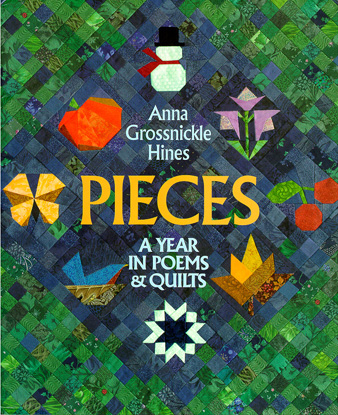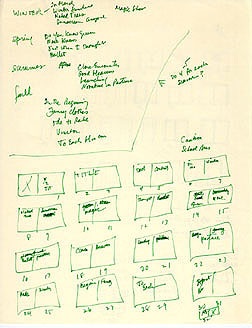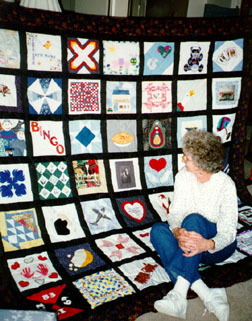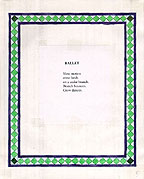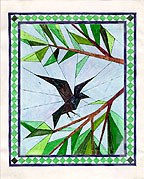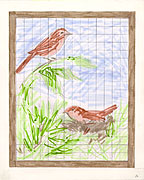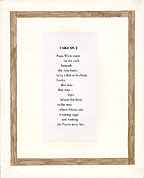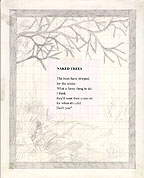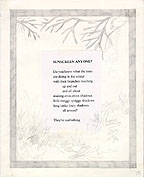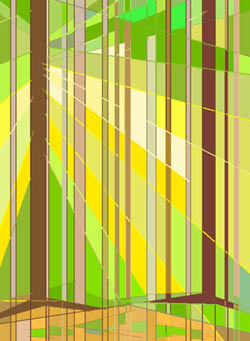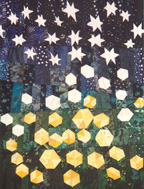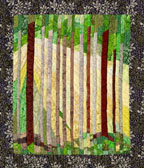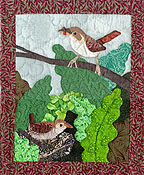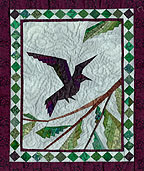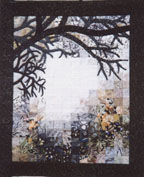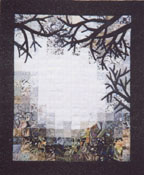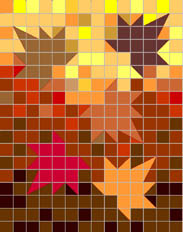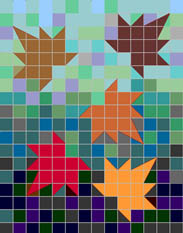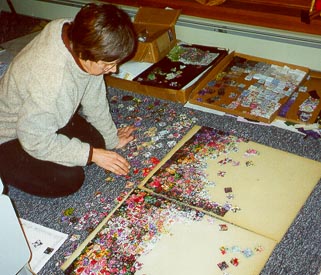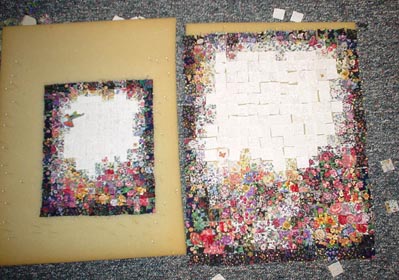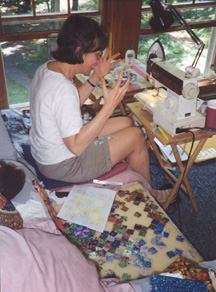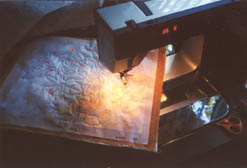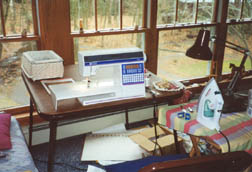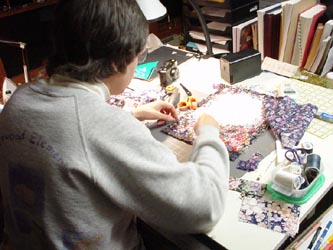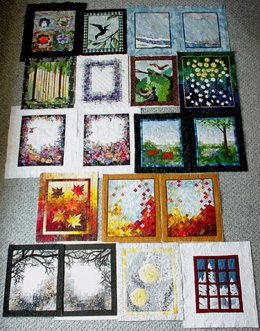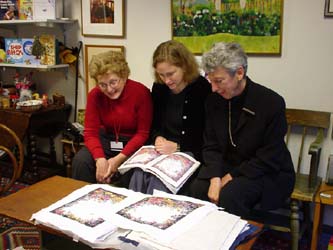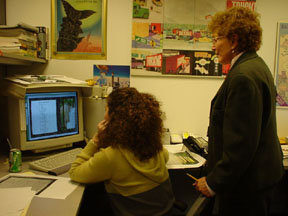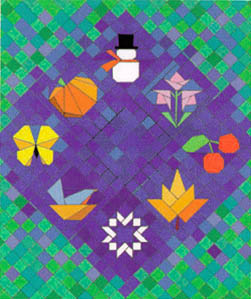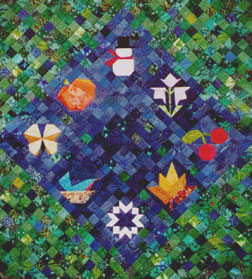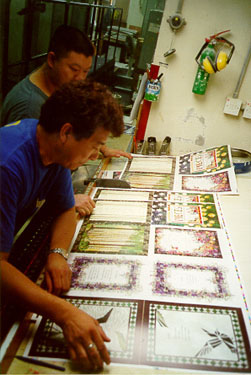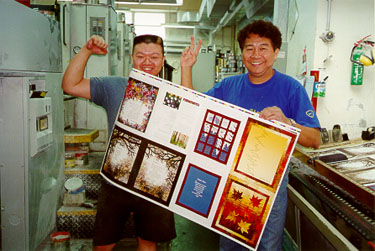Whistling: My second book to be illustrated with fabric!
Winter Lights: A Season in Poems and Quilts: My third quilt book, 2005.
Reviews, Honors and Awards for PIECES:
Lee Bennett Hopkins Award for Children's Poetry 2002
National Parenting Publications Awards (NAPPA) Gold Medal for poetry and folklore, 2001
NCTE Notable Children's Books 2002
Kentucky Bluegrass Award Nominee for 2002-2003
Texas Bluebonnet Masterlist for 2002-2003
Oregon's Beverly Cleary Children's Choice Award Nominee for 2004
Society of Illustrators Original Art Show, 2001
Junior Library Guild Selection
Allentown Art Museum Exhibit, 2001
American Textile History Museum Exhibit, 2002
Miniature Quilts, pattern for "To Each His Own", Issue 52, 2001
American Quilter, "Quilts in a Children's Book, The Making of PIECES: A YEAR IN POEMS AND QUILTS" Winter 2002
 Starred Review Hines raises the bar considerably for illustrators working in fabric,
pairing 20 new or previously published seasonal poems with spectacular quilted
and appliquéd piecework scenes. Reproduced in roughly actual size,
each piece features combinations of printed and patchwork flowers in glorious
profusion, sturdy trees with and without leaves, sunbeams, starry skies, falling
rain, and stylized but recognizable animals, all demonstrating dazzling mastery
of color and pattern. Though it seems almost unfair, the poetry is brilliant
too, evolving the "patchwork pattern / making up a year," from the freshness
of early Spring--"Brand new baby yellow green / bright bold biting busy green
/ until it seems/ everywhere one goes / green grows" through a summer lawn
"astronomical / with dandelion blooms," to Autumn's falling leaves--some
float / lazily / wavily / and taking all / daysily..." The quilts each
have unique individual characters, but there is a strong overall consistency
of style too, and since they were designed as illustrations, the unity of
text and picture is (paradoxically) seamless. And they are so exquisitely
reproduced that the temptation is to touch the page to feel the fabric.
Hines explains in a postscript how the quilts came to be, and provides sources
of information for novice quilters--but even readers with no interest in
the craft will stop in their tracks to admire this tour de force. Starred Review Hines raises the bar considerably for illustrators working in fabric,
pairing 20 new or previously published seasonal poems with spectacular quilted
and appliquéd piecework scenes. Reproduced in roughly actual size,
each piece features combinations of printed and patchwork flowers in glorious
profusion, sturdy trees with and without leaves, sunbeams, starry skies, falling
rain, and stylized but recognizable animals, all demonstrating dazzling mastery
of color and pattern. Though it seems almost unfair, the poetry is brilliant
too, evolving the "patchwork pattern / making up a year," from the freshness
of early Spring--"Brand new baby yellow green / bright bold biting busy green
/ until it seems/ everywhere one goes / green grows" through a summer lawn
"astronomical / with dandelion blooms," to Autumn's falling leaves--some
float / lazily / wavily / and taking all / daysily..." The quilts each
have unique individual characters, but there is a strong overall consistency
of style too, and since they were designed as illustrations, the unity of
text and picture is (paradoxically) seamless. And they are so exquisitely
reproduced that the temptation is to touch the page to feel the fabric.
Hines explains in a postscript how the quilts came to be, and provides sources
of information for novice quilters--but even readers with no interest in
the craft will stop in their tracks to admire this tour de force.
--Kirkus Reviews--Pointer Review December 15, 2000
 Starred ReviewThis lovely book combines the intricacies of quilting with the wonders
of the changing seasons. Though it is older readers and adults who will appreciate
the skill that has gone into the artwork, children will simply revel in the
colorful pictures that make up Hines's quilted squares. For the spring, a
rippled quilt in melting snow shades of white and blue captures the watery
beauty of the season. In autumn, reds, golds and browns show leaves "as pretty
as snowflakes." Perhaps the most powerful spread is a winter scene in which
naked limbs of trees and dark flowered underbrush are set against a background
of white. With such impressive pictures, it's easy to lose sight of the poems,
but they are quite nice in their simplicity: "Sometimes in winter / while
I'm sleeping / through the night / inside the house / all snug and tight
/ outside / the world is turning white." A two page spread at the book's
conclusion tells "the story behind the quilts," detailing in words and photos
how they were made. A bibliography is appended. A thoughtful, lovely offering. Starred ReviewThis lovely book combines the intricacies of quilting with the wonders
of the changing seasons. Though it is older readers and adults who will appreciate
the skill that has gone into the artwork, children will simply revel in the
colorful pictures that make up Hines's quilted squares. For the spring, a
rippled quilt in melting snow shades of white and blue captures the watery
beauty of the season. In autumn, reds, golds and browns show leaves "as pretty
as snowflakes." Perhaps the most powerful spread is a winter scene in which
naked limbs of trees and dark flowered underbrush are set against a background
of white. With such impressive pictures, it's easy to lose sight of the poems,
but they are quite nice in their simplicity: "Sometimes in winter / while
I'm sleeping / through the night / inside the house / all snug and tight
/ outside / the world is turning white." A two page spread at the book's
conclusion tells "the story behind the quilts," detailing in words and photos
how they were made. A bibliography is appended. A thoughtful, lovely offering.
--Ilene Cooper, Booklist--Starred Review, January 2001
 Starred Review In a series of designs worthy of exhibition, Hines illustrates the theme of deceptively simple, unique collection of poems; "Pieces of the seasons/ appear and disappear/ in a patchwork pattern/ making up a year." Her language, both playful and adroit, allows readers to see familiar seasonal changes anew. "Good Heavens," for instance, depicts a spring lawn as "astronomical / with dandelion blooms" that fill the green sky with "a thousand suns / and then / a thousand moons." Hines varies her quilt designs as often as she varies her poems' rhythm and rhyme schemes. On one of the longer poems, "Do You Know Green?," the words trickle down the page, much like the light that filters through the trees in the accompanying quilt; both the poem's construction and the long vertical tree trunks emphasize the forest's height and grandeur. Meanwhile, abstract quilts like the one featuring hundreds of flowered squares in "Misplaced?" stress frivolity'in this case, a joke involving a flowerbed where "bloomers are not sleepy heads." An appendix explains Hines's meticulous quilting process. Wearing two hats, Hines takes her quilter's stash of fabric swatches and her wordsmith's metaphors for memories of the seasons, and pieces together a unified, artistic whole. An outstanding book for aspiring quilters or anyone at all. Ages 5-up. Starred Review In a series of designs worthy of exhibition, Hines illustrates the theme of deceptively simple, unique collection of poems; "Pieces of the seasons/ appear and disappear/ in a patchwork pattern/ making up a year." Her language, both playful and adroit, allows readers to see familiar seasonal changes anew. "Good Heavens," for instance, depicts a spring lawn as "astronomical / with dandelion blooms" that fill the green sky with "a thousand suns / and then / a thousand moons." Hines varies her quilt designs as often as she varies her poems' rhythm and rhyme schemes. On one of the longer poems, "Do You Know Green?," the words trickle down the page, much like the light that filters through the trees in the accompanying quilt; both the poem's construction and the long vertical tree trunks emphasize the forest's height and grandeur. Meanwhile, abstract quilts like the one featuring hundreds of flowered squares in "Misplaced?" stress frivolity'in this case, a joke involving a flowerbed where "bloomers are not sleepy heads." An appendix explains Hines's meticulous quilting process. Wearing two hats, Hines takes her quilter's stash of fabric swatches and her wordsmith's metaphors for memories of the seasons, and pieces together a unified, artistic whole. An outstanding book for aspiring quilters or anyone at all. Ages 5-up.
--Publisher's Weekly--Starred Review, January 8, 2001
Pieces: A Year in Poems and Quilts is another gem of a book
with sewn illustrations. It illuminates the seasons with simple poems and
striking quilted pictures. The book has been handsomely designed, with the
poems well integrated into the quilts and borders on each page. Poetry has
been described as another way of seeing the world, and Hines' short poems
give the reader new glimpses into the beauty of the changing seasons. What
really took my breath away, though, are her intricate quilts, pieced together
over several years. Each hand-sewn piece beautifully interprets nature and
conveys the essence of its companion poem.
It's difficult to pick one favorite to share, but I'll try: Winter Sunshine
reads: "Today it is December./ Time for winter weather/and the air is frosty
chilly,/ only.../ No one told the rosebush/ and it has two yellow blossoms,/
two spots of sunshine/ to warm away the cold." Two roses sewn from triangles
of yellow fabric in various shades and patterns, are set against a black-and-white
background made up of floral prints, squiggles and other designs. An afterward
explains how Hines came to make the book and gives information about quilting
and further resources.
--Rochester, NY Democrat and Chronicle, April 22, 2001
Anna Grossnickle Hines was daunted by the idea of illustrating an
entire picture book with quilts. But she had gotten hooked on quilting and
wanted to give it a try. So Hines, author and artist of numerous picture
books, did the book in pieces, making the quilts one at a time over four
years. The result was well worth her lengthy labor. The quilts are
spectacular in their design and colors, while the poems range from playful
to poignant.
The book's title poem sets the stage: "Pieces of the seasons/Appear and disappear/In
a patchwork pattern/Making up a year." From there, Hines goes on to write
about crows, dandelions, wrens, autumn leaves and snow--all of the things
that make up a year in the natural world. Hines also has a good sense of
humor, as shown in poems like "Ode to a Rake": "In the wind/the leaves fall/
floating/ fluttering/ pretty as snowflakes/ except.../ they don't melt."
As a bonus, Hines concludes with showing how she did the quilting for the
book and giving sources of more information about quilting for readers who
might be interested in trying it themselves.
--Karen MacPherson, Post Gazette, Pittsburgh, PA April 24, 200i, Minneapolis Star Tribune, May 7, 2001
The publisher aptly calls this book "a happy blend of stitches and
stanzas." In it the author-quiltmaker relies on carefully observing and appreciating
the seasons and on her mother's example of designing beautiful quilts. The
result is a unique and delightful children's book. The quilts are not in
traditional patterns, but instead depict freestyle scenes or moments from
nature's annual cycle. A combination of white, gray and mud colors characterizes
March. But the master touch is that the quilt strips are long and narrow,
running from upper left to lower right -- like slashing rain. Between the
brightening clouds curved above and the slush of puddles and waves horizontally
below, there is enough grayish room to overlay the text of a poem about squishing
mud, or another, on the opposite page, about a "great day for clouds." The
quilts are wonderful, the poetry is good, and the combination is unique and
in the tradition of good picture books, very well integrated. An appendix
tells the story behind the quilts and briefly (with illustrations) explains
the basics of quilt making. A short bibliography - including a Web site -
offers an introduction to the craft and a start for would-be quilters. For
readers 3 to adult.
--Julie Empric, Eckerd College Professor, for The Tampa Tribune and Times, July 22, 2001
As summer ends and fall begins, these poems invite readers to embrace
the last of this season and look forward to those that follow by reading through
this book. Each poem is accompanied by a quilt of Hines' design and creation,
and she provides "The Story Behind the Quilts" in the concluding pages of
the book. For readers who might want to try quilting, she provides a Web
site to begin their research, as well as some books to consult. Of course,
some readers might just want to return to the poems again and again and appreciate
the beautiful marriage of word and image, as in "Mirage": "Oh, phlox, I like/the
way you make/the garden floor/a purple lake."
--Toledo Blade, Toledo, OH, August 26, 2001
A feast for the senses lies between the covers of this book. Eye-catching
handmade quilts, created by Hines herself, are the backdrops for twenty of
her poems about the seasons. The first poem, "Pieces of the seasons/ appear
and disappear/ in a patchwork pattern/ making up a year" sets the stage for
what is to come. The poems present the sights, sounds and smells of the seasons,
beginning in early spring with a crow alighting on a cedar branch. In subsequent
quilts, pastels give way to multi-hued flower beds of summer, followed by
the orange and yellows of fall, that give way to shadows and the ice blue
shading of a winter night. The poems beg to be read aloud, with strong rhythms,
strong images, delightful use of language and onomatopoeia. Hines presents
the story behind the quilts and discusses her process at the end of the book.
She dedicates the book to her mother who gave her the sage advice: "If that's
what you want to do, that's what you should do."
Sharon Saluzzo, Children's Literature Newsletter, April 2001
Anna Grossnickle Hines has sewn a book of poems. Actually, the poems,
which she wrote, are printed on top of quilted backgrounds, which she made.
The effect is that of something fixed yet lively, flat yet soft.
Hines suggests the seasons through palette and the patterns of her fabrics.
She also pieces fabric into images -- a yellow rose, a dusky crow --contained
within the poems. Some of the illustrations are more abstract in style than
others. The poems "In March" and "Just When I Thought," for instance,
are paired with rainy scenes constructed with slanting strips of blue and
gray. These strips, in turn, are embroidered with swirling rows of stitches
that evoke the invisible, restless air of spring.
One of the book's most complicated quilts depicts a forest. Vertical pieces
of fabric representing trees are juxtaposed with diagonal strips that fan
out like rays of golden light. The accompanying poem--"Do You Know Green?"--describes
the plants of spring in terms of motion:
"To Each His Own," one of the most appealing poems in the book, contains invented
words that express the irregular dance of falling leaves:
Some
skip-a-dip
bippity
floppity
flippity
toppity
tippity
plippity down.
And some just drop
flop.
As these examples show, Hines has command of such poetic tools as onomatopoeia,
rhythm and rhyme, yet it's her artful presentation of the poems that stands
out. The book concludes with and explanatory section titled, "The Story Behind
the Quilts," which reveals that Hines had never done such intricate quilting
before. A photograph of Hines in front of her sewing machine, her hands tensed
because of a mistake she has just noticed or just made, gives kids a realistic
model of a grown-up working hard at something new. Although one wishes
the photograph were larger, it enhances our appreciation for the artist and
her task. Seams had to be re-done, the caption says, and so they were--repeatedly,
if necessary. Which says a lot about this gorgeous book.
--Mary Lou Burket, Riverbank Review, Summer 2001
If you aren't a quilter, you will be when you read Pieces: A Year in Poems and Quilts. The art of quilting has never been more
exquisitely displayed than in this book. 20 original poems celebrate the seasons
joyously, evoking in words what we feel as we admire each quilt. In "Ballet"
the crow dances from one page to the next in slow motion. A most stunning
page is that showing vertical tree trunks of varying shades of brown and
green. Titled, "Do You Know Green?" you can feel the "Psst! Ping!, Pop! and
Pow!" as "green tickles the tips of twiggy tree fingers,". To encourage you
to try quilting, Hines tells the story behind the quilts accompanied by photos
of the process. Her mom is her inspiration.
--Jan Lieberman TNT, Winter 2001
Hines has illustrated her mostly free-verse poems about the seasons
with quilts. The selections, which describe weather, gardens, and animals,
are set against her patchwork designs. The fabric art, done in a broad range
of colors, are mostly representational, picturing animals and landscapes.
While a few are striking, those that depend on a fabric's print or the quilting
pattern come across flatly in reproduction. The poems are nicely descriptive,
but not distinguished. The most interesting part for readers may be the two
pages at the end that describe the quilting process, with a short bibliography.
The quilts in the book are Hines first, and took her several years to complete.
They will certainly inspire young quilters or artists to try something similar,
but as a collection of illustrated poems, Pieces fails to stand out.
--Nina Lindsay, School Library Journal
This collection of brief seasonal poems and accompanying quilted
illustrations traces the progression of the year from spring to winter. Shorter
poems, such as the poem about autumn foliage called "Pageantry" ("The trees
are wearing/ scarlet gowns/ and golden crowns/ and bits of them/ are falling
down"), tend to be more successful than the longer pieces, which sound somewhat
forced. For most of these poems Hines has created cloth designs that frame
the words, although a few of the quilt blocks appear to have been digitally
altered to create uncluttered background space for the text. In the poem
"Encore," about a hummingbird, the poem nestles in a quilted garden where
hummingbirds feed, and several stitched outlines of hummingbirds on the white
fabric background suggest their rapid motion in an almost cartoon-like fashion,
showing the outline of where the bird was moments ago. Hines also cleverly
arranges the quilted art, as in a two-page spread of poems about autumn,
wherein the left-hand page shows the leaves streaming down from the trees
while the facing page uses a similar quilt block upside down, so that the
leaves appear to be falling into piles at the bottom of the page. Despite
some unevenness in the poetry, the visual appeal and detail of the quilt
work will engage young viewers. Notes about the quilt-making process are
presented at the end of the book.
--KM The Bulletin of the Center for Children's Books
|
